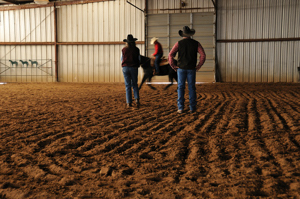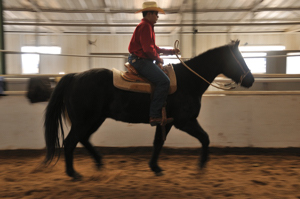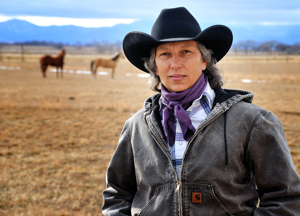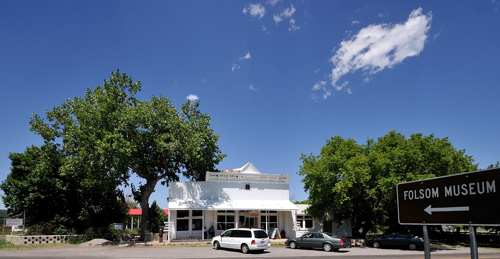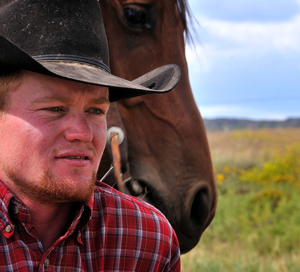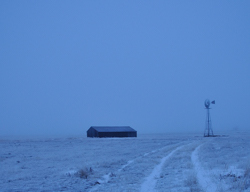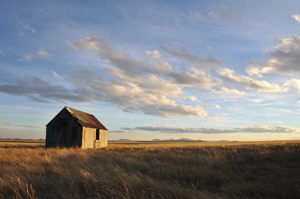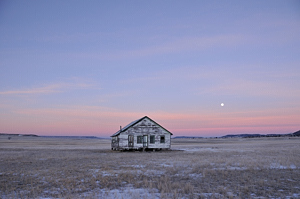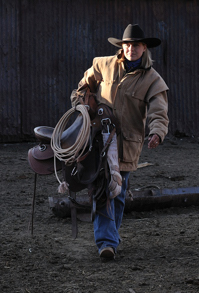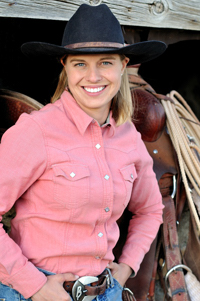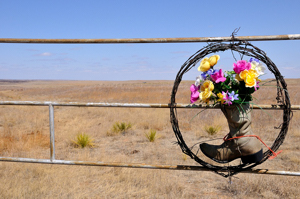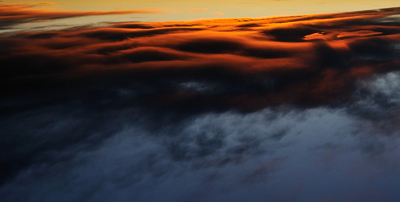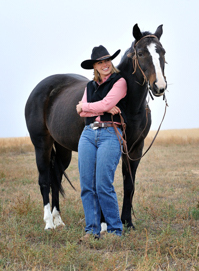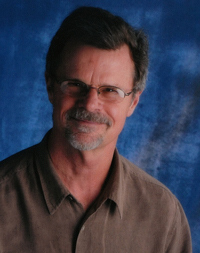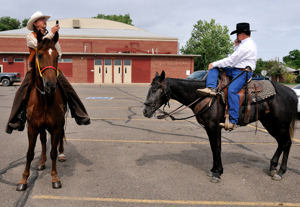|
Tim's Blog -- November/December 2009
December 24, 2009 Overcoming Challenges The heart of my Western Horseman Magazine feature on Ride to Pride would be the one-hour therapy session with 14-year-old Richard Pacheco, counselor Carole Jackson, and equine professional Greg Esquibel. I became concerned as I realized what a challenge it would be to meet Western Horseman's high quality standard for images in this indoor arena. The problem was the combination of motion and darkness. I used flash, which brought two of its own problems: I'm not that good at it, especially in such a fast-changing situation, and the horse flinched every time the flash went off. For the flash, I switched from aperture priority to fully manual exposure, turning off the automatic ISO as well, leaving that fixed at 200. That meant I had to ride the dial for every shot. Luckily, in shooting RAW, I can adjust the exposure two full stops up or down when I process in the computer. That helped. The other key was digital photography: it doesn't cost anything to fire off a lot of shots and hope to get lucky! These are two of the photographs I'm submittiing to Western Horseman with my 1900-word feature. Pending the editor's approval, "Rescued Horses, Rescued People" (my working title -- they may change it) will run in a spring issue of the magazine. What an amazing year it's been! Thank you for visiting. Merry Christmas and Happy New Year!
December 20, 2009 When Numbers Get Serious I got a little nervous Friday afternoon. After taking 160 shots of Mary Lou Kern for a feature I wrote for RANGE, the counter on my camera suddenly reverted to zero. I had visions of losing a couple hours' work and having to start over. But the subsequent images were there on the card: they just started over, so I had two number ones, for example. I thought maybe I'd hit some heretofore-unknown reset button. I remained nervous until I got home -- an hour's drive -- and uploaded the photos into the computer: they're all here. Then I could see what happened. My Nikon D300 assigns a file number to each shot, like this: DSC_9977. After 9999, it starts over again at 0001. I shot 10,000 photographs in the first year with my camera, and Friday I finished a second 10,000 barely past my two-year anniversary. The numbering turned over again. (I've averaged more than two dozen shots per day for two years, though of course they come in bunches: I shot 240 Friday, but none during the preceding week.) But while I'm shooting, that's not the number I see; rather, I see a count of the shots on the current memory card: a simple 1, 2, 3, and so on. (I can get just over 300 RAW image files on one 4GB memory card, and I carry 3 cards.) Apparently, when the camera file turned over from 9999 to 0001, it triggered the memory card count back to zero, too. The images went 158, 159, 160, 1, 2, 3, etc. I've no idea why this would happen. It must have happened a year ago, too, but obviously I was not on an assignment; I didn't even notice when it happened. Serious pros carry not only extra memory cards, but two cameras. I'm not there...yet! By the way, that's a picture of Mary Lou, above -- one of the photos I feared I might have lost. I blogged about the interview and photoshoot on my TKA Blog today, so I won't repeat myself here. I'll be back in 2-3 days with a report and photos from my next assignment, at Ride to Pride in Las Vegas. Hasta luego.
December 14, 2009 Good news...by e-mail An e-mail from New Mexico Magazine arrived late this afternoon, full of attachments including a contract and a tax form: the 2010 New Mexico Vacation Guide will include 7 of my photographs. I'm thrilled. I can't tell from the contract which images were selected, but I can figure out a little. The Vacation Guide is organized by region and five of my shots are between pages 52 and 59, so that's going to be northeastern New Mexico. (Years of reading detective novels gave me this uncanny ability.) Two other shots are on pages 35 and 103. At least one of those is likely to be Albuquerque or the Santa Fe area. Another may be a more generic page. One image is a half-page or larger; the other six are less than a half-page each. In fact, three share page 57, so that's bound to be the Des Moines/Folsom area, perhaps including the image above. The Vacation Guide will be published soon, and you can have one sent to your mailbox anywhere on earth for free by clicking here. I know it's easy 'cause I beat you to it.
December 13, 2009 The Cowboy Rides Away Riley McNabb was one of a dozen local cowboys who spent twelve-hour days moving 550 head of cattle from Black Canyon up onto Johnson Mesa and then down all the way to Des Moines, NM, mostly by two-lane highway. I shot this photograph of Riley at a mid-afternoon water stop -- for men, horses, and cattle -- at the Dry Cimarron River where it meets the Colfax/Union county line on the west end of Sunny Hill's Rainbow Ranch. I'm fond of the portrait. Many sprawled in the grass while others stood chatting. Riley sat on the ground, the only rider whose horse stayed right with him. Of course, it's the two together that make the portrait -- that and the wide open spaces stretching to Johnson Mesa in the background. I assume Riley was working for day wages; most were. That was the fall of last year. By Christmas, I heard that he had joined the US Army, and lately I've learned that he is stationed in Iraq. Our local school has taken up a collection to send him small gifts. His brother, Tristan McNabb, who also rode herd that day, is a student at the school. Hours after I took this portrait of Riley, I shot a final picture of the day. The cattle had been moved into a box canyon for the night (the next morning is another story) and Riley was coaxing a stray from under a bridge. The sun had set. It's been a popular image, one I dedicate to Riley today. I call it "The Last Cowboy".
December 6, 2009 Into the Storm. Or Not. It's eight degrees Fahrenheit outside, an hour after the rising of a dilute sun. Two years ago -- camera new, hungry for winning images -- I regularly set an alarm to venture into the frozen predawn darkness in hopes of luck and a good photograph.
For this photo, taken midway between Des Moines and Capulin on December 27, 2007, I stood in a dark fog before dawn, the temperature at zero, my hands jammed deep into my pants under the long underwear to keep my fingers warm enough to press the shutter release when the time came. My camera stood ready on the tripod. A snowstorm was due from the north, but I hoped for a momentary break in the sky from the east, beneath the clouds, when the sun rose: that would have been magic time. It never came. The snowstorm arrived instead. The successes? There was the time it rained all night and I met the dawn shooting east across Bennett's flooded pasture. (Studio C sold a framed print of this image last week.) The morning the first Capulin Volcano Run allowed me up the volcano to shoot at dawn -- normally the national monument is closed at that hour. The morning I shot a passing truck and an approaching car on the highway (and learned that everything is much closer than it looks through a 10mm lens! I almost got run over.) The first morning of the cattle drive, starting out by the church on Johnson Mesa. The most successful was near the volcano -- in fact, all these but the cattle drive were shot within three miles of each other: award-winning Lonely House with Moon was shot just three days before the cold blue image above. A look at my Landscapes Gallery shows several others with similar light, but those were taken around sunset rather than sunrise -- a much more civilized and hospitable time for photography! The fact is that the best light, certainly for landscapes, occurs at the beginning and end of the day. By using the dawn, you double your possibilities. Doing magazine and newspaper work -- essentially photojournalism -- has shifted my focus (no, that's not a pun, or shouldn't be) from landscapes to storytelling. I'll be up before dawn tomorrow to drive to Las Vegas to cover a story that may well have me shooting in falling snow -- and I'm looking forward to it! But I wasn't out in the dawn to try for a landscape photo today.
December 5, 2009 A Retrospective As I wrote here eight days ago on the one-year anniversary of the launching of this website, I was not thinking of another anniversary of at least equal significance: exactly one year before launching the website, Nikon released its new D300 digital camera and on that day it became the first camera I ever purchased. I took 10,000 shots that first year (and almost as many in the second) and had done well enough to launch this site with more than 100 of them, and to attract the attention of Western Horseman's senior editor, leading to my first professional writing as well. Two years ago this weekend, driving home from work over Johnson Mesa on Friday afternoon, my camera was a week old and I was barely learning to use it. I got my first great shot, Distance, before I had begun to learn how to process the new digital images in my new computer software: this shot is straight out of the camera. Now that I've learned how to process, I sometimes have to remind myself that one of my three most successful images had no processing whatsoever. Less is more. That photo, enlarged to 16"x24" and framed, hangs in a Rio Rancho recreation center, purchased for $1400 through a New Mexico Arts program. Two weeks later, in the first dawn of December 24, 2007, I stood next to my tripod waiting for the light just north of Capulin, NM. The temperature was 8 degrees, snow on the ground, my hands tucked in so I'd be able to feel my trigger finger when the moment came. When it arrived, here's what it looked like: The photo, Lonely House with Moon, had minimal processing and has been very successful. A very large framed print, the image 20"x30", now hangs in our living room. It, too, reminds me that the best shots need little or no processing. Nowadays I have lots of processing options, but my default moves are to add contrast and sharpness. That's all. Then I'll add whatever else a shot calls for, though sometimes I subtract, going back to the camera's image. When I was a teen learning photography from my dad, Jack Keller, who had college training to be a professional photographer, and from my high school art teacher Clare Frisch Steinberg ("Simplicity is a virtue") at Palisades High School, I was taught to frame the perfect shot in the viewfinder, not to rely on cropping and processing to "fix" the shot. It's still my goal. So, two years after my first shots with the D300, and a year after launching my website, I'm looking back and marveling, appreciative and feeling blessed. It's still going well: last weekend's Brittany Rouse photos (see below) drew an appreciative "Yes!" from Western Horseman's editor and he's rushing my feature into the February issue, on newstands in mid-January, where it joins my lengthy feature, The Long Riders: Crossing America from Mexico to Canada on Horseback, the first time I've had two features in one issue. If a snowstorm doesn't stop me, I have a substitute at school Monday so I can spend the day in Las Vegas, NM, reporting and photographing my next Western Horseman feature. Life is good.
November 29, 2009 An Elusive Shot Regular readers know that I've been after a single vertical-format portrait of New Mexico colt trainer Brittany Rouse for some time. Western Horseman has accepted the Women of the West feature I wrote for them, but I've failed to get a vertical portrait to their standard for a full-page image. (See November 14, below.) Britt was good enough to drive all the way up here to Des Moines, New Mexico, 3 1/2 hours in her Ford F-250 diesel ranch pickup, so we could get the job done. We shot in the late afternoon (red shirt, below) at Rhodi Martin's here in town, then at dawn at Darien & Dianne Brown's ranch (right) on the Dry Cimarron River along the Colorado border. This morning I sent seven photographs to Ross Hecox, Western Horseman's Senior Editor and a great photographer himself. I'll be hoping to hear back during the week, and I'll be disappointed if we didn't make the cut this time! With some luck, this two-page feature will run in the spring, text on the left, photo on the right. Brittany and I have worked hard for it! I drove down in April to spend a full day at her place on the Conchas River, meeting husband Don and kids Kourtnie and Kyle, interviewing Brittany and photographing her in action. Ross asked me to rewrite my feature into a Women of the West interview format, and he liked what he got, but I didn't have a vertical portrait. A rushed attempt in evening sleet outside Clayton last month fell short. This go 'round, we had plenty of time and opportunity, and no excuses. The whole deal was productive and fun...so the prospects feel good.
November 27, 2009 A Happy Birthday One year ago today, the morning after Thanksgiving 2008, this site -- TimKellerPhotography.com -- was launched. I had no idea of all that was in store: it's been an exciting year. A month later, I added TimKellerArts.com, folding TKA into TKP though maintaining them as separate sites. I've learning to be a webmaster, creating and adding all content myself, including at least one blog on each side every week. In fact, combining the roles of writer, photographer, and webmaster has proven to be productive, successful, and fun. The sites averaged 100 daily visitors last month. About a quarter of them are from outside the United States. So far this month, I've had 109 visitors from Israel, 85 from Germany, and dozens more from Russia, Latvia, Brazil, Ukraine, India, Singapore, France, and South Korea, in that order. Many other countries are represented in smaller numbers. (By the way, I can't tell who has visited -- only how many and where they're from -- which is one reason I appreciate those of you who leave comments: thanks!) I'm working on many projects -- I have a magazine photo shoot this afternoon and tomorrow morning, and reporting and photography for two new magazine features between now and Christmas -- so it's an exciting time. I appreciate your visit -- thank you for helping make this such a successful first year.
November 22, 2009 A Quick Abstraction I vaguely remember driving home from work -- the camera data tells me it was Friday, November 6, at 5:10 p.m. -- and pulling over to take a picture of a great sunset. I took only one shot, and I left it in the camera. Last night I processed the memory card for some new shots and was reminded of that sunset: it was the first image on the card. Here's what it looked like. I played around and came up with what you see above. (Click the picture above to see it large and compare it to the original frame.) As you can see, I flipped it over and cropped to a small portion of the original frame. That's all it did, but it sure produced a different picture. I love abstracts, and especially the fine line where representation melts into abstraction. I like to think the image above hovers successfully at that line.
November 14, 2009 Getting Good Enough After reworking my feature article on young horse trainer Brittany Rouse into a shorter "Women of the West" format for Western Horseman, I set about trying to get a good vertical portrait to take the full page opposite the text in the magazine. WH liked a portrait I'd taken at Brittany's remote ranch house, 167 miles away, but it was horizontal. After she worked all day at the monthly Clayton Auction, Brittany borrowed the auctioneer's horse and tack and we set out into the sleet and 28-degree white sky. We did the best we could under the circumstances. Western Horseman's Senior Editor Ross Hecox, himself a fabulous photographer, wrote, "I think the text works well, but the photo didn't quite do it for us. I don't think there was one specific issue that ruled it out, but there were a lot of little things -- crumpled reins, white sky, unflattering jeans (not trying to be mean), maybe too much makeup? The reins bother me, and I'm afraid the reins would cause some readers to doubt her credibility. "This is a photo that would work for a lot of articles in our magazine, and you've submitted some great stuff. But for it to be a full-page Woman of the West, the bar is higher. I'm hoping for a portrait that immediately convinces me that she's the real deal. Your portrait of Archie West did that. Your portrait of Brittany from the original photo shoot was great, it just needed a looser, vertical crop, and the bright background was a little distracting. "I know that we're so picky. And I understand that you had a small window to complete the last portrait. But I've shuffled things around, and we have time now to get another shot of Brittany, if it's possible. With a little more time, I know you can nail a good portrait." This kind of detailed feedback has been typical of Ross -- I've asked for it and he's given it. He was the editor responsible for spotting my cattle drive photographs after an editorial assistant had already sent me a rejection slip, and he brought me into the magazine. His detailed feedback has led me to consider him a mentor. He sent me this photo, an "environmental portrait" (the subject in her environment) as a suggestion of what I might do with Brittany during winter, simplifying matters by not having to include a horse. I love the shot, and feel fully capable of getting something like this with Brittany. I won't have to worry about white sky, or jeans, or crumpled reins. (Crumpled reins! I have no business working for a magazine that has Horse in its title. I should be shooting for Surfer Magazine!) I'm looking forward to getting back together with Brittany for one more try. I'll keep you posted.
November 13, 2009 Studio Portraits While waiting to put my new two-sided studio backdrop into action, my school picture came through. As school pictures go, it's not bad. The guy took just one shot, too. The company is LifeTouch. Teachers get a free picture. My backdrop is 10-feet wide and 24-feet long, a medium charcoal on one side, dark charcoal to almost black on the other. Studio C's West Gallery is 10-feet wide, so I've installed a fixed hanger at the end of the gallery. I'll hang the backdrop right over the art on the walls. I'm looking forward to giving it a good workout with some volunteers to model as I move my two flash units around in umbrellas on stands. We have a snowstorm moving in this weekend, and I have essays to grade, but I think the five-day Thanksgiving break is going to be an immersion in studio portrait photography.
November 8, 2009 Lens I haven't time to say much on photography, so it's a good opportunity to recommend another site worth your attention. Lens is the New York Times' photojournalism blog. Subtitled "Photography, Video, and Visual Journalism", it's an extraordinary site and a great place to get lost. There's new content daily, from around the world. If that's not enough, the archives are endlessly rich and valuable. Check it out.
|
